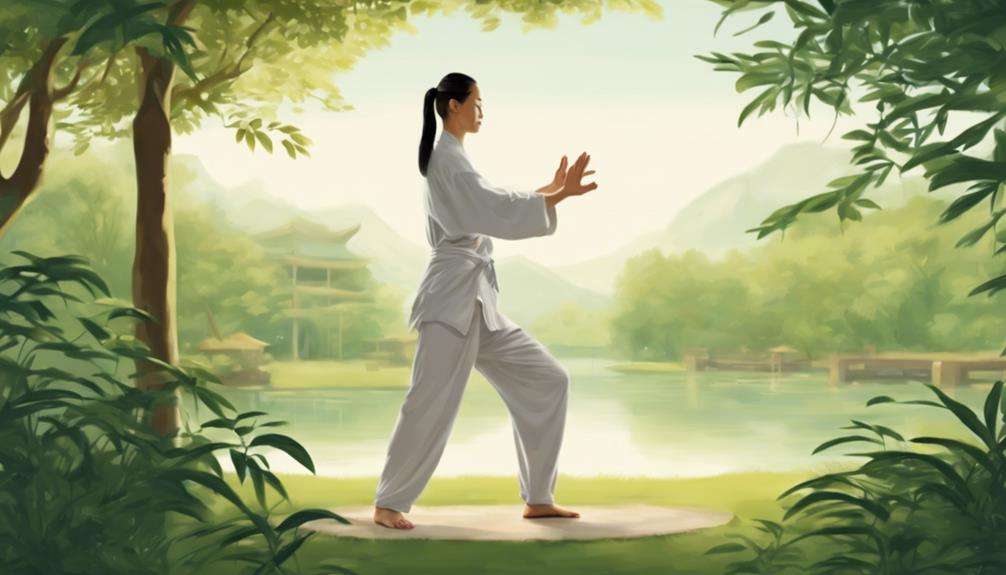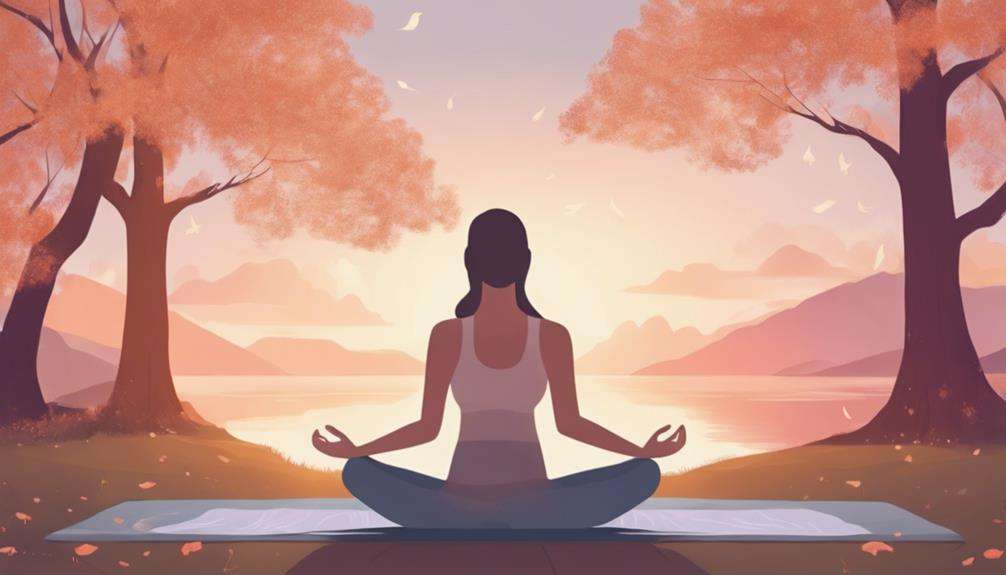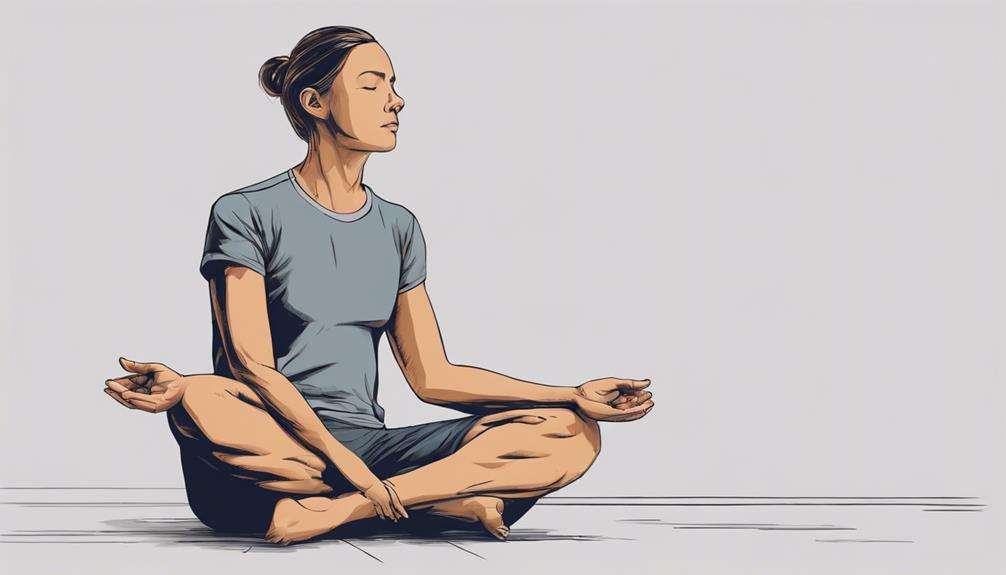You might not be aware of the profound impact that mindful movement meditations can have on your overall well-being.
Imagine a serene space where you can effortlessly unwind and let go of the stresses of the day.
These 7 meditations offer a unique blend of gentle movements and focused breathing techniques that can help you achieve a state of ultimate relaxation.
Whether you're looking to improve your sleep quality or simply seeking a moment of tranquility in your day, these practices have something to offer everyone.
Key Takeaways
- Engage in gentle yoga flow or Tai Chi for relaxation and reduced stress.
- Practice mindful stretching routines for improved flexibility and peace of mind.
- Explore walking meditation and dance meditation for calmness and stress relief.
- Utilize mindful breathing exercises to enhance relaxation, focus, and sleep quality.
Gentle Yoga Flow for Relaxation
Discover the soothing practice of gentle yoga flow for relaxation, a calming journey that gently guides you towards a state of peace and tranquility. Through guided meditation, you can explore into a world of deep relaxation, allowing your mind to quieten and your body to unwind. As you flow through the gentle yoga poses, each movement is a reminder to breathe deeply and be present in the moment. The deliberate stretches and mindful shifts help release tension from your body, bringing a sense of ease and comfort.
Incorporating gentle yoga into your routine can offer numerous benefits, from improved flexibility to reduced muscle tension. The practice not only nurtures your physical well-being but also nurtures your mental and emotional health. By engaging in this practice, you create a space for yourself to let go of the stresses of the day and find a moment of serenity. Whether you're a beginner or a seasoned practitioner, the gentle yoga flow is a beautiful way to unwind and rejuvenate your body and mind.
Walking Meditation Practice
Embrace the gentle rhythm of your steps as you commence on the serene practice of walking meditation, focusing on each sensation with mindfulness and presence. With each stride, pay attention to the subtle movements of your feet and legs, grounding yourself in the present moment. As you walk, notice the rise and fall of your chest, feeling the beating of your heart in tune with your steps. Let the natural surroundings envelop you, connecting you to the environment around you.
Walking meditation isn't about reaching a destination but about the journey itself. It's a practice that encourages you to slow down, breathe deeply, and center your thoughts. By immersing yourself in this simple yet profound activity, you can lower your heart rate, release tension, and invite a sense of calm into your being.
Whether you choose to walk indoors or outdoors, allow each step to guide you towards a state of tranquility and inner peace. Embrace the therapeutic benefits of walking meditation as a way to reduce stress and enhance your overall well-being.
Tai Chi for Stress Relief

As you explore the domain of stress relief techniques, consider delving into the serene practice of Tai Chi, a gentle form of exercise originating from ancient Chinese martial arts. Tai Chi offers a gateway to inner peace and relaxation through its slow, flowing movements and emphasis on deep breathing.
Here are a few reasons why Tai Chi can be a crucial tool in cultivating a sense of calm:
- Stress Reduction: Tai Chi has been shown to lower cortisol levels, the stress hormone, while increasing the production of endorphins, the body's natural painkillers. This dual action can help alleviate stress and promote relaxation.
- Physical Benefits: Improved balance, flexibility, and strength resulting from regular Tai Chi practice not only enhance physical well-being but also contribute to a sense of overall calmness.
- Emotional Balance: Regular sessions of Tai Chi have been linked to reduced anxiety, improved mood, and better sleep quality. These emotional benefits play a crucial role in stress relief and maintaining a sense of calm.
- Mindful Movement Meditation: Incorporating Tai Chi into your routine provides a mindful practice that encourages relaxation, mindfulness, and a profound sense of inner peace, making it an indispensable tool for achieving ultimate relaxation.
Mindful Stretching Routine
When starting a mindful stretching routine, remember to breathe deeply and let your body guide the movements.
Focus on the sensations in your muscles and joints as you stretch, allowing yourself to relax and release tension.
Embrace this gentle practice to cultivate a moment of peace and well-being in your day.
Stretching Basics
To start your mindful stretching routine, focus on gentle movements that promote flexibility and release tension in your body. Here are some basics to guide you through this calming practice:
- Start Slow: Begin with slow, intentional movements to warm up your muscles and joints.
- Breathe Deeply: Remember to sync your breath with each stretch to deepen your relaxation and enhance the mind-body connection.
- Listen to Your Body: Pay attention to how your body feels during each stretch and adjust the intensity accordingly.
- Stay Present: Keep your attention on the sensations in your body and the rhythm of your breath to fully immerse yourself in the stretching experience.
Benefits of Stretching
Ease into your mindful stretching routine and discover the multitude of benefits it brings to your body and mind. By incorporating regular stretching into your daily routine, you can improve flexibility, range of motion, and posture.
Stretching helps reduce muscle tension, stiffness, and soreness, allowing you to move more freely and comfortably. Increased blood flow and circulation from stretching promote relaxation and stress relief, enhancing your overall well-being.
Mindful stretching also heightens body awareness and mindfulness, connecting you more deeply with your physical self. Consider adding a stretching routine before bed to improve sleep quality and induce a state of relaxation.
Embrace the positive effects of stretching on both your body and mind, nurturing yourself with each mindful movement.
Dance Meditation for Calmness

Indulge in the soothing practice of dance meditation to cultivate calmness and inner peace. Dance meditation combines the benefits of movement and mindfulness, offering a unique way to commence calmness and inner peace amidst life's chaos.
Here's how dance meditation can help you:
- Release Stress: Through gentle, flowing movements set to music or rhythmic beats, dance meditation allows you to let go of accumulated stress and tension in your body and mind.
- Improve Well-being: By engaging in dance meditation regularly, you can reduce stress levels and improve your overall well-being, leading to a more balanced and harmonious life.
- Express Emotions: It provides a creative outlet to express your emotions and feelings through movement, fostering a deeper connection with yourself and your inner world.
- Enhance Clarity: Dance meditation enhances mental clarity, emotional stability, and physical flexibility, helping you navigate life's challenges with a clear and focused mind.
Commence on this journey of self-discovery and relaxation through the graceful movements of dance meditation.
Qigong Meditation for Tranquility
Begin on a journey towards tranquility through Qigong meditation, a gentle practice that harmonizes movement, breath, and mindfulness for inner peace and balance. Qigong meditation integrates slow, intentional movements with focused breathing to cultivate Qi, promoting relaxation and equilibrium in both your mental and physical being. By engaging in this ancient Chinese tradition, you can nurture a profound sense of inner calm, reduce stress, and enhance your overall well-being through the power of mindful movement.
Through regular practice of Qigong meditation, many individuals report experiencing heightened mental clarity, decreased anxiety levels, and a boost in energy. This practice serves as a valuable tool for fostering relaxation, improving the quality of your sleep, and enriching your emotional state by instilling a deep sense of tranquility and centeredness. Embrace the serenity that Qigong meditation offers, allowing it to guide you towards a state of peaceful harmony within yourself.
Mindful Breathing Exercises

Begin on a journey of tranquility and inner peace by immersing yourself in the practice of mindful breathing exercises. Deep breathing is a powerful tool that can help you find calmness and serenity amidst the chaos of everyday life. Here's how you can start:
- Focus on Your Breath: Begin by finding a comfortable position and bringing your attention to your breath. Notice the sensation of air entering and leaving your body.
- Practice Deep Breathing: Take slow, deep breaths, allowing your belly to rise and fall with each inhale and exhale. Feel the tension melting away as you breathe deeply and intentionally.
- Engage in Diaphragmatic Breathing: Place one hand on your chest and the other on your belly. As you breathe in, make sure that the hand on your belly rises higher than the one on your chest. This technique helps calm the nervous system and promote relaxation.
- Try Box Breathing: Inhale for a count of four, hold for four, exhale for four, and hold for four. Repeat this cycle several times, focusing solely on your breath and letting go of any distractions. Embrace the peace that comes with each breath.
Frequently Asked Questions
Can Mindful Movement Meditations Help With Chronic Pain Management?
Mindful movement meditations can be a valuable tool for pain management. By tuning into your body and breathing, you may find relief from chronic pain. Stay open to this practice; it can bring comfort.
Are There Any Specific Precautions or Modifications to Consider for Individuals With Physical Disabilities or Limitations?
Mindful movement with physical limitations? Explore adaptive modifications that cater to your unique needs. Embrace the journey with patience and self-kindness. Your practice can flourish, tailored to your individual capabilities.
How Long Should Each Mindful Movement Meditation Session Typically Last for Optimal Relaxation Benefits?
For prime relaxation benefits, aim for mindful movement meditation sessions that last around 15-30 minutes. This duration allows you to fully immerse yourself in the practice, connecting breath with movement, and nurturing a sense of peace and calm.
Are There Any Specific Breathing Techniques Recommended to Enhance the Relaxation Effects of the Movements?
Take slow, deep breaths to enhance each movement's relaxation benefits. Inhale deeply through your nose, feeling the expansion in your belly, then exhale slowly through your mouth, releasing tension with each breath.
Can Mindful Movement Meditations Be Practiced in a Group Setting, and if So, Are There Any Specific Guidelines to Follow for a Group Practice?
In a group setting, mindful movement meditations can enhance relaxation through shared energy and support. Stay attuned to group dynamics, respect individual boundaries, and foster a sense of unity. Together, you can deepen your practice and cultivate relaxation.
Conclusion
You've completed 7 mindful movement meditations for ultimate relaxation. Did you know that 75% of people who practice meditation report improved sleep quality?
Keep up the good work and continue to prioritize your well-being. Remember, taking time for yourself and practicing relaxation techniques like these can have a positive impact on your overall health and happiness.
Stay present, breathe deeply, and find peace within. You deserve it. Keep on meditating!






